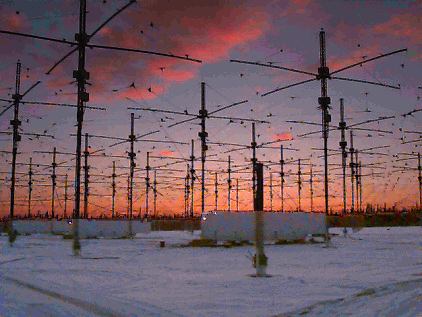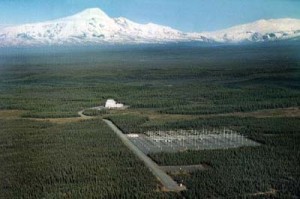
Video - Social Media Stops HAARP: HAARP To Be Shut Down This Summer - The Power of Social Media
Josey Wales
Just because they are shutting down HAARP in Alaska don’t ever think HAARP is a thing of the past, in fact the last two videos in this post may give you some insight into the future of HAARP!
FAIRBANKS — The U.S. Air Force gave official notice to Congress Wednesday that it intends to dismantle the $300 million High Frequency Active Auroral Research Program in Gakona this summer.
The shutdown of HAARP, a project created by the late Sen. Ted Stevens when he wielded great control over the U.S. defense budget, will start after a final research experiment takes place in mid-June, the Air Force said in a letter to Congress Tuesday.
The University of Alaska has expressed interest in taking over the research site, which is off the Tok Cutoff in an area where black spruce was cleared a quarter-century ago for the Air Force backscatter radar project that was never completed. But the school has not volunteered to pay $5 million a year to run HAARP.

Responding to questions from Sen. Lisa Murkowski during a Senate hearing Wednesday, David Walker, deputy assistant secretary of the Air Force for science, technology and engineering, said this is “not an area that we have any need for in the future” and it would not be a good use of Air Force research funds to keep HAARP going. “We’re moving on to other ways of managing the ionosphere, which the HAARP was really designed to do,” he said. “To inject energy into the ionosphere to be able to actually control it. But that work has been completed.”
Comments of that sort have given rise to endless conspiracy theories, portraying HAARP as a superweapon capable of mind control or weather control, with enough juice to trigger hurricanes, tornadoes and earthquakes.
Scientists say all of that is nonsense, and that the degree of ionosphere control possible through HAARP is akin to controlling the Pacific Ocean by tossing a rock into it.
Built at a cost of more than $290 million, the site has 180 antennas on 30 acres that are used to direct energy into the ionosphere, which is 55 miles to 370 miles above the Earth, and monitor changes in the flow of charged particles. Stevens was the godfather of HAARP, which he helped start two decades ago with annual earmarks slipped into the defense budget.
At the hearing on defense research and innovation, featuring six representatives of the Pentagon, no one said HAARP has a future in the defense budget.
Walker said the Air Force has maintained the site for several years and the last project is one by the Defense Advanced Research Projects Agency (DARPA). Once completed, the site will close.
It is a question of money. In these federal budget – cutting times, the roughly four million dollars a year needed to maintain the facility is getting scrutinized.
HAARP is owned by the Air Force Research Laboratory, but was until recently operated by an Anchorage contractor, Marsh Creek.
Steve Floyd is the principal systems engineer for Marsh Creek. He says HAARP’s money woes started with last year’s sequestration cuts.
“Our contract through Marsh Creek to run the facility, came to an end in the middle of June of 2013. And I guess it’s the sequestration cuts that really squeezed the budget and the Air Force Research Lab decided to save some money and take it dark for a while.”
He says the cost cutting measures are ill-advised, because the research done there is valuable. Floyd says the ionosphere has a strong impact on satellite communications, but not enough is known about how that works.
“So we’ re transmitting out with a focused beam, doing a very, very, very minute but detectable stimulation of the plasma of the ionosphere with these what are really very standard short wave radio transmissions, but it is just enough to do a cause and effect study of the ionosphere.”
Floyd says the research conducted in Gakona has far reaching implications for both military and commercial communications systems.
“HAARP is in Alaska because we wanted to be underneath a region of concentrated ionosphere called the auroral oval. And we all have marveled at the Northern Lights, and what that is doing is painting out this hollow ring of concentrated ionosphere, that’s caused by the Earth’s magnetic field. And we wanted to be underneath that auroral oval a good percentage of the time.”
He says there’s no better site than Gakona for the research facility. Bob McCoy agrees. McCoy and his fellow researchers argue there’s a lot more science to be done in Gakona. McCoy says there’s a possibility that the defense department could find an entity willing to share the costs of HAARP’s upkeep.
The Air Force is paying for HAARP ionospheric research now going on through this month and in May of this year. During that time, HAARP will be inventoried to determine if some of its equipment can be used to support other scientific activities elsewhere. Meredith Mingledorff, a public information officer with the Air Force Research Laboratory at Kirkland AFB in New Mexico, says in an email:
“The Air Force favors the transition of the HAARP facility to a basic research organization.”
But that depends on funding. If no other organization can be found to pay expenses:
“The Air Force plans to decommission the research site…and initiate divestiture in June 2014.”
The cost of the deconstruction has not been established yet.
DARPA Director Arati Prabhakar said, “The ‘P’ in DARPA is projects. We’re not in the business of doing the same thing forever, so very naturally as we conclude that work, we’re going to move on. It’s not an ongoing need for DARPA despite the fact that we had actually gotten some good value out of that infrastructure in the past.”
Walker said the Air Force would like to remove critical equipment this summer to avoid the expense of winterization.
Alan Shaffer, assistant secretary of defense for research and engineering, said HAARP is a “world-class facility,” but the department does not need it anymore.
“With all the other issues and problems and challenges facing the department at this time, we just don’t see that that investment, over a long-term period, is where we would prioritize our investment,” said Shaffer.
“No one else wants to step up to the bill, ma’am,” Shaffer said to Murkowski.
On another topic, Murkowski asked Shaffer about small modular nuclear reactors for remote areas. She said, for example, Eielson Air Force Base could benefit from “reliable energy security that nuclear power can provide.”
Shaffer said the “sticker shock” of an initial $1 billion investment for a small nuclear reactor is a huge obstacle.
Reach Dermot Cole at dermot@alaskadispatch.com.
For those still inclined to deny the facts, here are TV weather persons talking about, showing and admitting to weather geoengineering, plus dramatic statements.
David Walker, Deputy Assistant Secretary of the Air Force for Science, Technology and Engineering, very-matter-of-factly states that they took over from the Navy and will be moving on.
The new HAARP system. Mobile and able to travel the world.
The US Navy is reportedly deploying the huge Sea-based X-band radar to the Korean Peninsula



